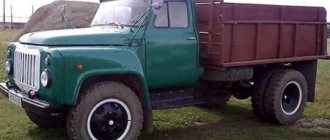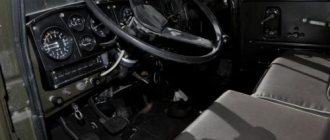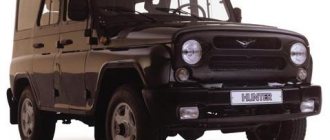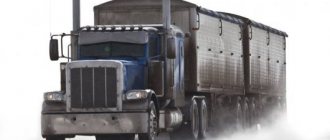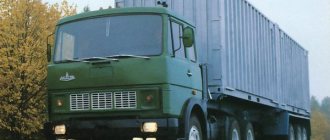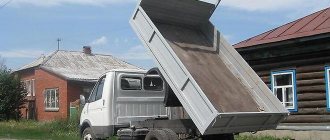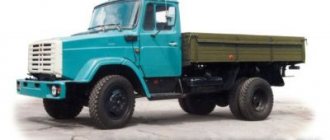The DAF 95 HF is a reliable truck tractor. Although there is no official representative office of the manufacturer in Russia, it is often preferred by carriers. You can only purchase a DAF 95 HF with mileage, since production of this model was stopped in 2007, but cars are delivered from Holland in perfect condition, which allows you to use the car on a par with new domestic analogues. Although there are more powerful modern cars, this model still remains in demand.
About profitability and more...
Model: XF 105.460 Year of manufacture: 2013
Read
All issues of the DAF XF105.410 online diary
Fedor M.
“For me, the most important advantage is the cost-effectiveness of transportation. By purchasing DAF equipment, even despite the situation on the cargo transportation market, we still remain, although not a big one, in the black. Spare parts are inexpensive, and scheduled maintenance is also quite reasonably priced. Another plus is the high liquidity of the machine.”
Evgeny Morozov
“You can talk a lot about the advantages and disadvantages of a particular brand; liquidity, service stations throughout Russia and the availability of spare parts are important for business. In terms of these indicators, DAF has no equal.”
Sergey Belenkov, founder of BS-Trans NN LLC:
| “As a result of operating DAF equipment, with an annual mileage of 200,000 km, an objectively higher level of profitability was achieved. This result was made possible due to a 10% difference in fuel consumption and a 30% difference in prices for spare parts and service. As a result, simple arithmetic gave every reason to finally settle on the optimal tractor option for solving growing transport problems.” |
About equipment and repairs
Model: XF 105.460 and 95.430 Year of manufacture: 2010 and 2002
Leontii
“I had DAF 105.460 and DAF 95.430 (2010 and 2002 respectively). I have always only ridden Dafas. There is something to love them for. The chassis is excellent, the engine is responsive, and the cabin is comfortable. The engine is powerful.
True, there are also disadvantages: on the 95th, the automatic transmission “flyed” and had to be repaired. If you undergo maintenance on time, there will be no problems. When buying a car, pay attention to what the seller is like. By the way, the manual transmission has never let me down. If you choose by power, I recommend 460 hp to everyone.”
Read
DAF trade secrets. Report from the Eindhoven plant
Dovlat
“My company purchased 4 identical DAFs, one went to me. Changed oil and filters. Well, that's common. The car rides smoothly, although the cabin is on simple springs and not on air cushions. The shock absorbers can be adjusted for stiffness. Sound insulation is also okay. Consumption ranges from 30 to 42 liters, depending on driving style, load weight, and road condition. The car has one spacious tank. Automatic transmission (16 gears). I think there's too much switching.
The autonomous heater operates quietly and can be adjusted from the bed. The car has cruise control, air conditioning, on-board computer, hill start assistance system, and drive axle locking. For some reason, a refrigerator is not provided, but by the way, it would not hurt. Now about the cons. Our car is Euro-5 class; one day we got low-quality diesel fuel in the tank, and as a result the display showed errors. Urea consumption is about 2 liters per 100 km.”
Driver, works on DAF XF105:
| “High-quality and inexpensive service, availability and availability of spare parts - all this is important for daily operation. The truck tractor works in conjunction with a refrigerator that transports consumer goods and food. Full load - 20 tons, routes along federal and regional highways with very different quality of road surfaces, weekly mileage - in the range of 3000-4000 km,” the driver noted. |
Operating experience of DAF 95 and 85 series
But first, let's figure out who is who. DAF series 95 trucks are the top of the Dutch company's model range. Cars in this series are designed for intensive use with annual mileages of 150 thousand km and above. The 85 series cars, standing one step below, differ from the flagship in simplified configurations, less comfortable cabins and less powerful engines. In addition, the 85s have an average safety margin and are designed for low intensity use on local and regional routes.
In Russia today, the most common trucks are the DAF 95XF series, which debuted in 1997. Slightly less common are the tractors and chassis of the older DAF 95 models, which were produced until about the mid-90s, when they were replaced by the more modern XF series. The least represented here are the DAF 85, which appeared in 1992-1993, and the DAF 85CF trucks, which replaced the previous 85 in 1998. The newest generations of trucks, already designated as DAF XF85 and CF95, were presented in 2000 and 2002, respectively. In Russia, the DAF 95XF with Super Space cab is still extremely rare, so we will not focus on them.
Cabins. DAF trucks of the 95th series operated in Russia are mostly equipped with high double cabs Space cab and the flagship Super Space cab (its internal height is 2255 mm); on vehicles of the 85th series there are mainly Comfort cabs with a low roof and one sleeper place. For all types of cabs, two types of suspension are offered: pneumatic (the airbag is combined with a shock absorber) and spring-shock absorber (90% of DAF 85 series are equipped with this option). The reliability of air and mechanical suspensions is approximately at the same level and directly depends on driving style, road quality and timely maintenance. More specifically, on old DAF 95s with large cabs, the bushings and silent blocks of the cab front suspension can withstand approximately 80 thousand km of shock absorber mileage on our roads - about 150-200 thousand km. On the DAF 85 the suspension lasts longer, as these cars have lighter cabs. On the more recent models 95XF and 85CF, the cab suspensions were improved, the rigidity of the shock absorbers was increased, so that the mileage of these suspensions became much longer. But, we repeat, in each individual case, the life of the suspension parts depends on whether the driver slows down on uneven surfaces or drives according to the principle “more speed - fewer holes.”
On older DAF 95s, the front suspension of the cabs proved to be too soft and prone to “breakdowns” on uneven surfaces. Therefore, in order to increase the stiffness of the suspension, our savvy drivers have resorted to using so-called “screeds”. The suspension brackets on the DAF 95 have through-holes through which a long steel rod with threads at both ends is passed. Then nuts are screwed onto this rod on both sides. When tightened, the nuts seem to tighten the brackets, which stand on the support shaft with some distortion. After this operation, the suspension really becomes stiffer and even the knocking noise disappears due to worn bushings. But this is a temporary improvement, and soon the bracket breaks so much that it has to be replaced entirely. Operators also sometimes tighten the nuts with such force that the aluminum suspension brackets simply bend.
Let us also note that due to untimely replacement of an air filter clogged with dust, it happens that the electric motors of the fans of the standard cabin “stoves” burn. The filter costs about 300 rubles. and changes in a couple of minutes. A new stove motor already costs several hundred euros and takes much longer to replace.
Engines. The same engine was offered for the DAF trucks of the 95XF and 85CF families, which debuted in 1997 on the updated flagship DAF 95XF. This 12.6-litre 6-cylinder in-line turbodiesel XF series with 4 valves per cylinder, direct injection and intercooler was created by DAF based on the previous 11.6-litre VS series diesel engine, which was equipped with the old DAF 95. For the 85CF series trucks, a new the engine was offered in 360, 381 or 428 hp versions. On the flagship 95XF, this engine, depending on the version, develops 381, 428 or 483 hp.
One of the features of the XF engine is that it (like its 11.6-liter predecessor) is equipped with an in-line mechanical injection pump manufactured by Bosch, while the engine complies with Euro-2 standards. In Russia, Bosch pumps have proven themselves to be simple, reliable and high-quality products that resist our fuel for a long time, and problems with them arise only from age and wear and tear. The survivability of these units is also evidenced by such a case when, at a gas station, the driver of an old DAF 95, which had a similar pump installed, somehow managed to add... about 400 liters of 92-grade gasoline into the tank! And with this “cocktail” the truck reached Finland, having traveled about half a thousand kilometers. The most interesting thing is that in the end nothing happened to the engine, although the mileage on the car was already over a million kilometers!
If a mechanical injection pump even allows fuel and water to pass through itself, then the injectors are far from being so omnivorous. Our fuel often jams them, splits the nozzles, or the nozzle stops spraying fuel normally.
Another feature of “Daf” engines in general and the 12.6-liter version in particular is that they have “dry” cylinder liners. Accordingly, such an engine is more heat-loaded and has some operating features. Thus, it is strongly not recommended to turn off the engine immediately after loading. The fact is that in a running engine, the hottest point is the cylinder head. After a sudden stop of the engine, the coolant begins to rise upward, to the hottest place, that is, to the head of the block. And since the coolant has a high coefficient of volumetric expansion, it can find its way out from under the head gasket. Such cases have happened, but this happened mainly on 95XF trucks with mileages of 700-800 thousand km. In any case, after a long load, it is better to let the engine “grind” for a couple of minutes at idle to cool down. By the way, this will also extend the life of the turbocharger. Air compressors from Wabco (mainly 95 series) and Knorr-Bremse are installed on DAF trucks. A small nuance: the air compressor from a 12.6-liter diesel engine is also suitable for an 11.6-liter VS series engine without modifications.
Among the “sores” on the engines of old DAF 85 and 95, leaks of the crankshaft oil seals and the fuel injection pump drive were noted. On more modern XF and CF models, the Dutch took these complaints into account and improved the design, making it more reliable. Springs also break in fuel priming pumps on old cars, but springs from MAZ are suitable for emergencies.
The most powerful engines for DAF trucks were supplied by Cummins for a long time, and these engines were installed only on the flagship 95 series. The six-cylinder 14-liter turbodiesel of the famous N14 series with electronically controlled pump injectors on the old DAF 95 developed 500 hp, but on the more recent DAF 95XF the engine was boosted to 530 hp. (2350 Nm at 1000-1300 rpm) and met Euro-2 standards. Let's say right away that the Cummins engines installed on DAF have been seriously modified to meet European requirements. For example, initially the electronic control system of an American engine works in the so-called inch system. But in Europe, the metric system of measures is adopted, so a special decoder unit is installed on the engine, which converts feet, inches and gallons into more familiar meters, centimeters, liters, etc. Along the way, this adaptation allows you to diagnose an American diesel engine using standard DAF diagnostic computers, rather than purchasing separate motor testers from overseas for this purpose. In addition, all American engines have a 12-volt electrical system, while Europe runs on 24-volt electrics. Accordingly, 24 V on-board electrical equipment is installed on the “Europeanized” Cummins.
At the turn of the century, the era of Cummins diesels on DAF trucks ended. To replace the American engine, at the end of 1999, the Dutch released a new modification (designated XE390C) of their own 12.6-liter engine, boosted to 530 hp. Developing the same torque as Cummins, the Daf engine is lighter and smaller in size, has a high liter power and meets Euro-3 standards.
In Russia, Dutch trucks with American engines are a rare phenomenon. In any case, the service could only recall 6 similar machines. The Cummins engine has a lot of torque and is quite reliable, but it doesn’t like our diesel fuel, sometimes expressing its dissatisfaction with difficult starting. The main thing in such cases is not to get into the engine with playful hands, it will be worse. Here's just one example.
A DAF with a Cummins engine was brought to the service. The complaints are common: the engine does not pull, smokes, runs unevenly and starts poorly. It turned out that when the engine became difficult to start, the owners of the car decided to remove the low-pressure electro-mechanical fuel priming pump. The craftsmen dismantled this pump, they couldn’t do anything, but they broke the seal of the gaskets, which is why the fuel system began to suck in air, and the Cummins stopped starting at all. But the descendants of Levsha and Kulibin were not at a loss and installed another fuel priming pump from KAMAZ into the fuel line from the tank! One problem: since the fittings of the domestic pump did not coincide with the diameter of the foreign fuel lines, here and there on the “product” there was insulating tape and a clamp... Naturally, because of this, airing of the fuel system began again.
In another case, interference with a Cummins engine ended much worse. The so-called central timing unit (CTU - Central Timing Unit) on the engine failed, which controls almost all devices on the truck that operate at any time interval, from wipers and turn signals to hazard warning lights and the engine stop system. The owners of the truck decided to save about $400 for a new block, and threw the “makeshift” directly, bypassing the broken block. The machine seemed to work. But the owners apparently did not take into account that if the timer unit fails, the range shift solenoid valve in the gearbox also stops functioning. No, this valve does not fail, it simply stops receiving a signal to switch from the “timer”. As a result, only 5th, 6th, 7th and 8th gears were left at the driver’s disposal. For some time, the mighty American engine courageously coped with the task of starting a loaded road train from 5th gear. But this could not continue indefinitely: first the clutch burned out, and then the thick flywheel of the engine burst through! The car sat for a month waiting for a new flywheel to be brought from the States.
And finally. One day a DAF 95 arrived at the service where we contacted for information, the drivers of which complained about poor engine performance. When asked when the engine oil was last changed, the guests answered that it was a million (!) kilometers ago! Moreover, all this time the engine was running on oil for diesel engines... passenger cars! When the mechanics, stunned by such statements, removed the oil pan, they discovered something resembling a mixture of tar and Vaseline. What kind of normal engine operation could we be talking about here?! The unfortunate engine was brought to such a state that the piston skirts began to melt in pieces to the cylinder liners...
Therefore, dear owners, in order not to repeat the mistakes of others and then become the talk of the town, remember and follow some service recommendations. The engines of the previous DAF 85 and 95 trucks are designed to run on mineral (!) oil, which in Russian conditions is recommended to be replaced every 30 thousand km. And the plant strongly advises against experimenting with both replacement periods and the use of other types of oils. There are cases when the use of “synthetics” ended with the engine going haywire!
More modern 12.6-liter DAF 95XF and 85CF engines can already use semi-synthetic and synthetic oils. “Semi-synthetics” in our conditions must be changed every 50 thousand km, and engines running on synthetic oil are additionally equipped with oil centrifuges, and in this case the oil change interval can be extended to 100 thousand km. Cummins diesel engines run only on “synthetic”, which in our conditions must be replaced every 50 thousand km (the coolant filter is also changed at the same time). It is recommended to change fuel filters on an American engine after about 50 thousand, and on DAF engines - after 30 thousand km. Air filters are replaced as they become dirty, and it is also better not to skimp on this: due to a clogged filter, fuel consumption may increase, and the turbine can be ruined.
Electrical equipment. The weakest point here is the electrical wiring. The old DAF 85 and 95 from the early 90s used thicker, more durable wires, but on trucks from the mid-90s the Dutch switched to smaller gauge wires. Moisture plus chemicals on our winter roads lead to the fact that after a few years, only a plastic sheath remains from such a wire, and the copper core itself oxidizes to the state of powder.
Another problem is that the wire harnesses themselves are encased in a corrugated plastic braid, and over time, due to vibrations when driving, the hard “ribs” of this braid begin to grind the insulation of the wires! At the same time, the seemingly sealed braid successfully allows moisture to pass through, and as a result, faults and short circuits periodically occur in the wiring, up to the burning out of entire wiring harnesses and fuse block boards. It happens that “behind the wires, the cars themselves burn to the ground... Such “aggressive” braiding was used not only on DAF 85 and 95 trucks, but also on the more modern XF and CF series until the end of the 90s. And only on new generation trucks that appeared at the beginning of this century, the Dutch finally took this drawback into account and switched to a smooth wire braid, which eliminated the problem. In addition, the widespread use of modern multiplex CAN digital data transmission buses has made it possible to reduce the sheer number of wires.
Generators and starters for DAF engines are produced by Bosch. The units are very reliable and fail mainly due to old age. Most used DAF trucks that come into our country are equipped with 55 amp alternators. (Sometimes, however, there are trucks with generators of 80 and even 120 amperes, but they are installed mainly on “northern” modifications or special versions such as a long-wheelbase chassis on which a refrigerator with a refrigeration unit stands). The Dutch believe that 55 amperes is quite enough for Europe, but in our harsh conditions such a generator is not always enough. This is especially noticeable in winter, when the generator often does not have time to charge the batteries, which in parking lots are drained by autonomous vehicles, televisions, walkie-talkies, etc. Of course, if your wallet is thick, you can buy and install a more powerful generator, but there is a simpler and cheaper option. At the service where we turned for information, they get out of the situation by installing 28 V relays on 55-amp generators instead of 24-volt charging relays, which gives a higher voltage and charging current, according to DAF recommendations. (The new generation DAF XF95 and CF85 already have “smart” electronically controlled generators that change their performance depending on the level of energy consumption).
As for batteries, in warm Europe the electrolyte density is considered normal at 1.24 - 1.25 g/cm3. But in our cold climate you won’t go far with such a battery, and often Russian owners of used “Dutch” cars have to buy suitable batteries instead of standard ones or raise the electrolyte density to a more acceptable level of 1.28-1.29 g/cm3.
Transmission. Most DAF 85 and 95 series trucks, both older and newer, are equipped with a 16-speed ZF manual transmission. It is extremely rare, but still there are cars with American non-synchronized gearboxes from Eaton. ZF and Eaton gearboxes are extremely reliable units, they last a long time and break down only due to age, wear, or downright barbaric use. It is recommended to change the oil in gearboxes every 90 thousand km.
Let us take a special look at the gear shift lever mechanism. To this day, all Daf trucks of the 85 series use the same simple scheme: when the cab is raised, the gearshift lever remains in place. On older DAF 95 trucks everything is more complicated. There, the gearshift lever sits on the cockpit and is connected to the rocker via a creepy-looking system of two separate telescopic rods, two locking locks and a set of rods. This sophisticated design requires increased attention during operation: the “telescopes” and locks must be regularly lubricated so that they do not “sour”, and also make sure that both locks open when the cabin is raised, otherwise you can bend the supporting platform of the scenes or break them “ telescopes." Accordingly, when lowering the cab, it is necessary to ensure that the telescopic rods fold without distortion, and that the locking locks snap securely when the cab is completely lowered. It is also necessary to promptly change the wearing plastic bushings that secure each tube in the “telescope”, otherwise one day when the cabin is raised, the rods may simply “unfasten”. On the 95XF models, the Dutch abandoned such a complex “telescopic” design, switching to a simpler and more reliable design.
The clutch on trucks is dry, single-disc, and during normal use (without frequent driving around the city or long slipping, for example), it can withstand a mileage of up to 1 million km, and the release bearing works the same amount. The clutch basket has a self-supplying plate as the disc wears out. Note that the old DAF 85 and 95 used a traditional pressure clutch basket, while starting with the 95XF and 85CF models, the Dutch switched to using push-type clutches, in which the bearing does not press the basket, but pulls it towards itself.
The reliability of drive axle gearboxes mainly depends on how drivers operate their vehicles. The “popularity rating” is dominated by long driving with the differential lock on. So, at the service center, no one is surprised by gearboxes with collapsed bearings, crumbled gears or differential crosspieces that are welded to the satellites. Drivers also often use blocking when the tractor is at an angle to the semi-trailer. This is not recommended, otherwise uneven loads can also damage the gearbox.
Suspension. The suspensions of 2-axle trucks are in most cases traditional: there are springs in the front, pneumatic elements with an ECAS control system in the rear. With regular lubrication, spring pins and bushings can withstand a mileage of over 200 thousand km. (On the new generations of DAF XF95 and CF85, instead of spring bushings and pins, they began to install more durable silent blocks)
Even in Russia, you often come across tractors and chassis with a 6x2 wheel arrangement and a third drawbridge. The raising and lowering of this bridge occurs automatically when the weight load on the machine changes. For this purpose, air pressure control sensors are installed in the air suspension. Inside such a sensor there is a thin silicon wafer that senses the air pressure in the air bag and converts the pressure into an electrical signal that is received by the ECAS electronic suspension control unit. Thanks to this signal, ECAS “sees” whether the vehicle is loaded or not. And based on these data, the automation accordingly lowers the “sloth” on a loaded vehicle and raises it on an empty one.
The drawbridge control provides a mode where the driver, by pressing a button, can briefly (for 40 seconds) lift the “sloth” on a loaded vehicle. This was done so that when starting on a slippery road, the drive axle could be additionally loaded to improve tire grip.
Troubles with the drawbridge can happen if the above-described faults and short circuits occur in the electrical wiring. In such cases, the “sloth” begins to live a separate life: either he suddenly rises in a loaded car, then falls in an empty truck, or walks up and down uncontrollably. And the control pressure sensors also do not last forever; due to age and chemicals on the roads, they oxidize and fail.
Brakes and steering. DAF remained faithful to traditional drum brakes on all wheels until the very end. The Dutch took their time and patiently waited for the new EBS electronically controlled disc brake technology to be fully tested and refined by other competitors. It was only in the early 2000s that DAF finally decided to use disc brakes on its trucks.
As for the service life of the old brakes, for example, on the DAF 95XF, depending on the driving style, the drums can withstand 600 - 800 thousand km. mileage, the resource of the pads is up to 400 thousand km.
In addition to the engine brake, trucks also have gearboxes with ZF or Voith hydraulic retarders. By the way, in winter you can still effectively warm up a truck engine while parked using a retarder. We turn on the retarder to the maximum level, it starts to work and heat up, and since the retarder has a liquid cooling circuit connected to the cooling system of the engine itself, after a few minutes the truck’s engine has time to heat up.
Not much can be said about the steering system. Steering gearboxes and power steering pumps are manufactured by ZF and are characterized by high reliability, and if they break, it is due to old age and natural wear. In order not to shorten the life of the steering mechanism, it is recommended to change the oil in it every two years. The original tie rod ends can withstand approximately 400 thousand kilometers on our roads. The conical kingpins of the front axles have plain bearings and, with normal lubrication, “run” indefinitely.
So, operating experience shows that the Dutch know how to make not only cheese.
Simple and unencumbered with electronics, DAF trucks operate successfully in Russia, and problems with them in most cases arise for the same long-known reasons, which, by the way, are also characteristic of trucks from other Western manufacturers. The first reason is a violation of operating rules, non-compliance with maintenance regulations and savings on spare parts and consumables reaching the point of absurdity. Secondly, domestic cargo carriers, when buying used trucks from Europe, mainly purchase vehicles originally created for countries with a mild climate, normal roads and high-quality fuel. And without additional preparation for the harsh Russian realities, expecting completely problem-free operation from such a truck is, to say the least, naive. The editors would like to thank the automotive, transport and Moscow representative offices of DAF for their assistance in preparing the material. Share
About the manufacturer's feature - the cabin
Model: XF 105.460 Year of manufacture: 2008
Dovlat
“The interior is spacious, although the roof is not the highest. The engine is great, pulls great, we can drive long distances with ease. They even carried up to 20 tons, and everything was fine. The sleeping bag is quite comfortable, soft, I fit freely. You can also move around the cabin without touching anything, and you can even stand upright.”
Look
All advertisements for the sale of DAF equipment
Larisa
“I worked on this machine. The DAF 105 is a good, solid car in which the driver does not strain at all. Fuel consumption is low, which is good. I wanted to increase the engine power to 510 hp. With. at the program level, it’s good that the officials have smart mechanics who clearly explained that this should not be done at all, as well as turning off the urea system. The service is also excellent, thanks to the specialists. I'm happy with the car."
Dmitry Karpukhin, representative, official DAF dealer in Nizhny Novgorod:
| “DAF trucks have always been distinguished by their functional interiors. Everything in it is thought out - from a clear interface to the arrangement of shelves that allow you to store a large number of things. Thus, the Space Cab is distinguished by an abundance of various pockets and compartments for small items. Its height allows you to stand at full height even in the area of the engine compartment, which, rising only 15 centimeters above the floor, does not interfere with free movement around the cabin.” |
Design
The vehicle is a representative of trucks. Despite the fact that its main distribution occurred in the Soviet Union, most truckers prefer to use the Daf XF 95. The design of the car does not differ greatly from its predecessors.
Exterior
The appearance of the vehicle is not pretentious. The first modernization of the vehicle took place in 1997. To avoid confusion, the creators had to adjust the labeling. Now the Daf car is decorated with the inscription 95 XF. The abbreviation means "to the fullest."
In appearance, almost every car is white, equipped with a large-sized cabin, with a missing hood. There is a radiator grille mounted at the front. During the initial inspection of the car, a bumper with markings catches your eye. The mirrors and headlights are harmoniously matched and also large in size.
The advantage of the modernized model is the installed ladder, which helps the driver and passenger climb into the cabin. In addition, owners note updated locks that provide increased security. The radiator grille is equipped with special steps that make it easier to wash the impressively sized windshield.
Due to these dimensions, visibility for the driver has increased.
The dimensions of the machine are as follows:
- length – 7.6 m;
- width – 2.4 m;
- height – 2.4 m;
- wheelbase - 3.6 m.
Interior
Truckers note the functional practicality of the interior. When using a vehicle, you can appreciate the advantages of Euro standards.
Behind the seats there are two spacious shelves designed for drivers to rest. Under the bottom shelf there is a compartment for storing personal items. If desired, this place can be equipped for small household appliances.
Project partners
| DAF Trucks NV is a leader in the production of light, medium and heavy-duty vehicles. It has production facilities in Eindhoven, the Netherlands, Westerlo, Belgium, Leyland, UK, and Ponta Grossa, Brazil, as well as more than 1,000 dealerships and service centers worldwide. | |
| BS-Trans NN LLC was founded in 2008. Rolling stock - 25 units of truck tractors. 3 types of semi-trailers: tilt, isothermal, refrigerated. All equipment in the fleet is no older than 2012; the trucks are equipped with the GLONASS satellite tracking system. Geography of transportation: all of Russia. |

